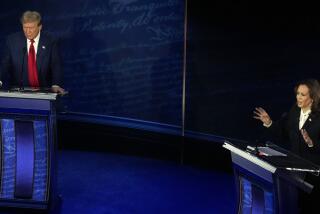In a Year There Will Be No President : Politics: Election forecasting is founded on ‘eternal laws’ that expire the next time voters go to the polls.
- Share via
In the months ahead, reporters will be seeking the Holy Grail of election forecasting: an analysis of historical voting trends that yields an airtight prediction of the 1992 presidential race. Well, here it is.
According to many rigorous studies, presidential elections hinge on economic well-being, as gauged by change in real disposable income per capita--what the average American clears after inflation and taxes. Since the late 1940s, no incumbent party has held the White House when income has grown less than 2% in the year before an election. But in recent months, this figure has been falling, and it probably won’t get far into plus territory by Election Day. Economic analysis dubs Bush a sure loser.
But which Democrat can win? Since the party’s first convention in 1832, none of its candidates has ever won the White House without carrying a majority of Southern states. And so it helps to have roots in Dixie: Nominees from the South have won 83% of the time, compared with only 38% for non-Southerners.
What’s more, most of the non-Southern winners have just squeaked by. Franklin Roosevelt is the only Democrat from outside the South to gain more than 51% of the popular vote. The last northern Democratic President, John F. Kennedy, won by less than three-tenths of 1%--and that slender margin may have come from graveyards in Texas and Chicago.
In recent decades, the South has been tipping toward the GOP. Since 1960, only one Southern state has ever gone to a non-Southern Democrat--and that was a fluke: The 1968 Nixon-Wallace split let Hubert Humphrey take Texas with 41%.
For Edmund G. (Jerry) Brown of California, Tom Harkin of Iowa, Robert Kerrey of Nebraska and Paul Tsongas of Massachusetts, these statistics mean that their chances are heading south.
This leaves Gov. Bill Clinton of Arkansas. Unfortunately for him, no sitting governor has won the presidency since 1932. There’s a reason for that. In the post-New Deal era, state governments have become large, troubled operations that demand constant attention from their chief executives. As Michael Dukakis discovered in 1988, state problems can distract a governor from the campaign trail and supply opponents with ammunition for negative campaigns: Witness Boston Harbor and the Massachusetts prison furlough program. That’s why Mario Cuomo bowed out--and why Clinton would have a steep climb.
Democratic woes do not stop there. Presidential contenders need a home base with some clout in the electoral college. In this century, every newly elected President has resided in a state with at least a dozen electoral votes. Iowa has seven, Arkansas six and Nebraska five--which means further trouble for Harkin, Clinton and Kerrey.
Massachusetts has exactly a dozen, but Tsongas is a cerebral Greek technocrat--and it’s hard to think of an election where the nation has chosen a clone of the previous election’s goat.
Virginia has 13 electoral votes and California has 54, but Brown shares an additional burden with Kerrey: Both currently lack a spouse. Americans place great emphasis on traditional family values, so not since Grover Cleveland have they chosen a bachelor as President. Even Cleveland got the message and wed in office.
Therefore, none of the Democratic candidates can win in November. And neither can President Bush. The historical data thus yield one clear prediction: A year from now, the presidency will be vacant.
This conclusion is absurd, which is the point. To make a solid forecast, one needs to analyze a large number of past events. When bookies reckon the odds in a horse race, they look at hundreds of previous races. When actuaries draw up life insurance tables, they examine millions of cases. By contrast, would-be political seers can look back on only 51 presidential elections in all: 42 since widespread use of the popular vote, 14 since the advent of modern polling and 11 since the first publication of Economic Report of the President, the source of most economy-based forecasts.
With so few dots to connect, even the best election forecasters cannot be sure that they yet have an accurate picture. A pattern that looks like an eternal law may turn out to be a time-bound phenomenon that expires with the next election. No Catholic had ever been elected--until Kennedy. No popular-vote loser had ever bounced back to take a subsequent election--until Nixon. And since Martin Van Buren, no incumbent vice president had ever won the White House in his own right--until Bush.
Election forecasts serve a useful purpose by testing theories about voting behavior. But these theories remain in an early stage of evolution, and their predictions are inevitably clouded by uncertainty. The only sure bet this fall is that some historical patterns will be broken and some forecasters will be wrong.
More to Read
Get the L.A. Times Politics newsletter
Deeply reported insights into legislation, politics and policy from Sacramento, Washington and beyond. In your inbox twice per week.
You may occasionally receive promotional content from the Los Angeles Times.










